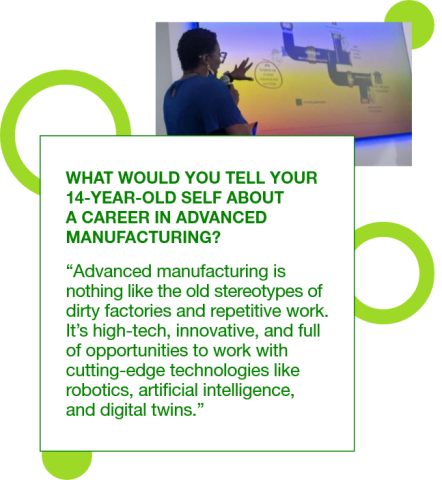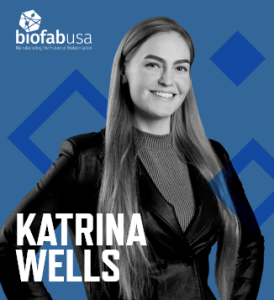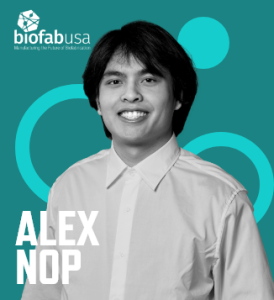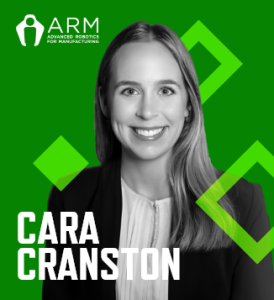
Dedicated Educator, Program Designer, Dancer
Jacqui Hall’s career is a powerful example of how passion and purpose can shape the future of an entire industry. With over 17 years at Semiconductor Research Corporation (SRC), Jacqui has spent her career building strong bridges between students, academia, and the semiconductor sector. From running research programs for students at every level to developing national strategies for workforce development, her mission has remained clear: create meaningful opportunities for the next generation.
Now serving as Director of Workforce Programs for SMART USA, Jacqui leads national efforts to prepare students and workers for high-tech careers in semiconductor manufacturing. She designs and scales training programs, builds strategic partnerships, and integrates innovative tools like digital twins and virtual reality into hands-on learning. These aren’t just high-tech buzzwords—they’re how Jacqui is modernizing workforce training to meet real industry needs.
What sets Jacqui apart is her personal dedication. She’s worked directly with hundreds of students, created platforms to showcase their research, and helped secure millions in scholarship funding. Most recently, she and the SRC team were awarded $10 million to support engineering students with an interest in semiconductors.
Jacqui doesn’t just build programs—she builds futures. With a Bachelor's degree in Sociology and additional training in Marketing and Management, her blend of experience, industry insight, and compassion for students makes her a leader who’s reshaping what workforce development looks like in the semiconductor space. If you're curious about where a career in advanced manufacturing can take you, Jacqui’s story is one to watch, and that’s why she’s a Modern Maker.
Q&A with Jacqui
How did you find your way to working in advanced manufacturing?
My path to advanced manufacturing wasn’t a straight line—it was shaped by curiosity, opportunities, and a passion for helping people find meaningful careers. I didn’t necessarily set out to work in this field, but along the way, I discovered how critical semiconductors are to everything we rely on, from smartphones to medical devices. Once I saw the impact I could have in building career pathways for students and workers, I was hooked!
One of the biggest lessons I’ve learned—and something I think younger audiences will appreciate—is that you don’t have to have everything figured out right away. I found my way into this field by saying yes to new opportunities, learning from mentors, and staying open to where my skills could make a difference. Advanced manufacturing is evolving fast, and there’s room for people from all kinds of backgrounds—whether you're into engineering, problem-solving, data, or even education and workforce development like me.


What is the most challenging part of your job?
One of the most challenging (and rewarding!) aspects of my role is bridging the gap between industry needs and workforce development. I work to ensure that our programs don’t just exist—they truly prepare students for meaningful careers in semiconductor manufacturing. Balancing the evolving priorities of industry partners, universities, and workforce organizations while scaling programs nationally is no small feat. Navigating these complexities requires persistence, collaboration, and a deep commitment to creating real opportunities for students while helping companies find the skilled talent they need. I’m passionate about connecting diverse stakeholders, aligning goals, and driving impact to build a stronger, more inclusive semiconductor workforce.
What is the best part of your job?
The best part of my job is knowing that the work I do is creating real opportunities for students and shaping the future of the semiconductor workforce. I love helping students—especially those who may not have had clear pathways into this field—gain access to education, training, and meaningful careers in this critical industry. It’s incredibly rewarding to see the direct impact of these efforts, not just on individuals but on a national scale.
I also thrive on the collaboration that comes with this role. Working alongside industry leaders, educators, and policymakers to drive workforce innovation—whether through digital twins, VR training, or new education models—is both exciting and meaningful. Knowing that my work helps bridge the talent gap and strengthens the U.S. semiconductor industry makes every challenge worth it.
What would people be surprised to learn about manufacturing or your role in manufacturing?
People are often surprised to learn just how advanced and high-tech modern manufacturing really is—especially in the semiconductor industry. It’s not just factory floors and assembly lines; it’s cutting-edge technology, AI-driven automation, and digital twins revolutionizing how we design, train, and produce.
One of the biggest misconceptions is that manufacturing is dirty or grimy. In reality, semiconductor fabrication happens in some of the cleanest environments on the planet—cleanrooms that are thousands of times cleaner than a hospital operating room. Workers wear full-body suits to prevent even the tiniest dust particles from contaminating the chips we rely on in everything from smartphones to medical devices.
In my role, I focus on developing the workforce that will power this transformation. What surprises people most is how much of this work is about creating opportunities—building pathways for students and workers to step into these high-tech careers, even if they don’t come from a traditional engineering background. Manufacturing today isn’t just about making things; it’s about solving big challenges, driving innovation, and shaping the future of technology.
What advice do you have for someone new to the industry or considering manufacturing as a career?
My biggest advice to someone new to the industry or considering a career in manufacturing is to stay curious and embrace continuous learning. Manufacturing today is driven by innovation—whether it’s automation, AI, or semiconductor fabrication—so being open to new technologies and problem-solving will set you apart.
Also, don’t be intimidated if you don’t have a traditional engineering or technical background. There are so many pathways into this industry, from hands-on apprenticeships to advanced degrees, and the demand for skilled talent is higher than ever.
Most importantly, say yes to opportunities—whether it’s a new project, a mentorship, or extra training. Some of the best careers in manufacturing start with simply being willing to learn and take that first step.
What makes you excited to go to work on Mondays?
What excites me about going to work on Mondays is knowing that every week brings new opportunities to make a real impact. Whether it's launching a new workforce initiative, collaborating with industry leaders, or helping students find pathways into semiconductor careers, I love the energy of working toward something bigger than myself.
Manufacturing is evolving so rapidly, and being part of that transformation—especially in workforce development—makes every day exciting. Plus, I get to work with an incredible network of passionate people who are just as committed to shaping the future of this industry. There’s always a new challenge to tackle, a new idea to explore, and a new way to help build a stronger, more skilled workforce.
What are the three most important skills for your job?
Strategic Collaboration – Workforce development in advanced manufacturing requires bringing together industry, academia, and government to build sustainable talent pipelines. Being able to connect the right people, align priorities, and foster partnerships is essential.
Program Development & Problem-Solving – Designing workforce programs that meet real industry needs means thinking creatively, identifying gaps, and finding innovative solutions—whether it's leveraging digital twins for training or creating new scholarship pathways.
Adaptability & Continuous Learning – The semiconductor industry is evolving fast, and staying ahead requires a willingness to learn, adapt, and embrace new technologies and workforce trends. Being open to change and always looking for ways to improve is key to success in this field.
At the heart of it all, my job is about creating opportunities, solving challenges, and building a stronger workforce for the future.
If you didn’t have to work, how would you spend your day?
If I didn’t have to work, I would spend my day doing a mix of creative, meaningful, and fulfilling activities. I’d start the morning with something that energizes me—maybe a dance class or a yoga session to set a positive tone for the day.
I’d love to travel, immerse myself in different cultures, and learn from people with unique perspectives. I’d also spend time painting, letting creativity flow as a way to express myself and unwind.
And, of course, I’d make time to enjoy good food, great conversations, and maybe even a peaceful moment with a book or a scenic walk along the beach, where the ocean always centers and inspires me.
Even if I weren’t working in an official role, I know I’d still be drawn to learning, creating, and making an impact in some way.
What activity gives you the most energy?
Dancing gives me the most energy! Whether it's taking a class or just moving to music, it instantly lifts my mood and recharges me. I also find a lot of energy in yoga—it helps me feel centered and strong, both physically and mentally.
What hobbies make you better at your career?

Dancing and yoga help me stay focused, resilient, and adaptable—key skills in my career. Dance improves my ability to think on my feet, embrace creativity, and stay energized, while yoga helps me manage stress and maintain a balanced mindset, especially when juggling complex projects.
How does the work you do impact the world?
The work I do helps build the workforce that powers the future of technology. By creating education and training programs in advanced manufacturing, I’m helping to ensure that we have skilled talent to drive innovation in industries like semiconductors, aerospace, and medical devices—things that impact nearly every aspect of our daily lives.
Through partnerships and hands-on training initiatives, I help open doors for people who may not have otherwise considered a career in this field. That means more opportunities for individuals, a stronger economy, and a more competitive and resilient manufacturing sector in the U.S.
Ultimately, my work isn’t just about jobs—it’s about empowering people, strengthening industries, and shaping the future of technology in a way that benefits everyone.




